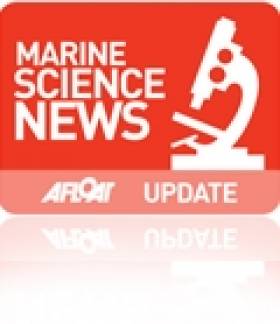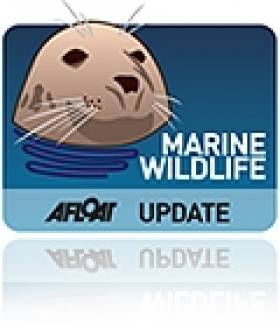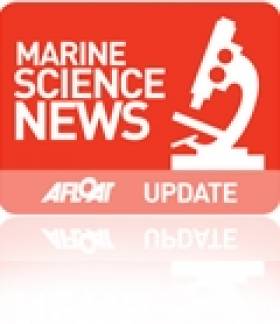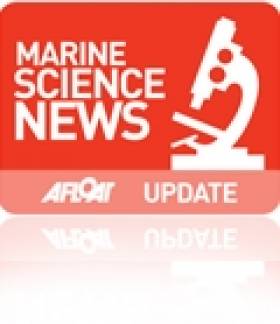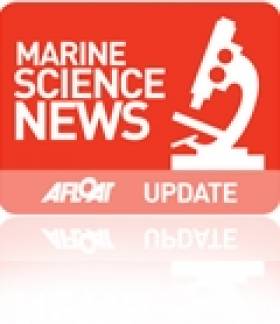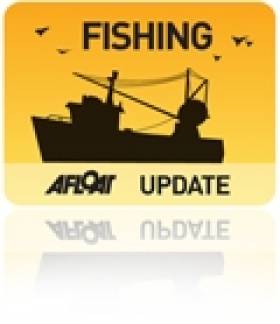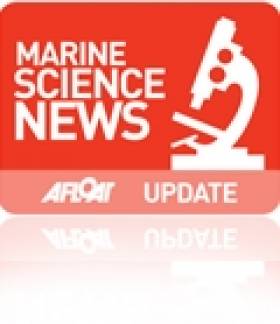Displaying items by tag: marine science
'Ocean Observatory' For Galway Bay
#MarineScience - A subsea cable laid from the RV Celtic Explorer in Galway Bay this week marks a major milestone in the development of Ireland's national marine research and development infrastructure.
The four-kilometre cable and a frame to which sensors and monitoring equipment will be attached are part of the development of an ocean observatory in Galway Bay connecting the Galway Bay Ocean Energy Test Site to the shore at Spiddal, Co Galway.
The cable will supply power to the site and allow unlimited data transfer from the site for researchers testing innovative marine technology including renewable ocean energy devices.
The Marine Institute and the Sustainable Energy Authority of Ireland (SEAI) have been working together to promote and develop Ireland's ocean energy potential, and this project – with partners SmartBay Ltd, UCC (MarEI - Marine Renewable Energy Ireland), and Dublin City University – is part of a programme to enhance the Galway Bay Ocean Energy Test Site.
A suite of sensors and environmental monitoring equipment will be installed on the cable end frame this summer, as well a floating 'sea station' which will give developers real-time data on how their devices are performing in the ocean.
"Ireland's sea area is around 10 times the size of our land area and with one of the best offshore renewable energy resources in the world, the opportunities to harness the power of the ocean are immense," says Marine Minister Simon Coveney.
"The new facilities at the Galway Bay Ocean Energy Test site will attract companies and researchers developing marine technology and renewable ocean energy equipment, and will position Ireland at the forefront of these emerging sectors by developing an expert indigenous supply chain that will expand as these sectors grow.
"The ocean observatory will also enhance our ability to monitor the ocean and better understand how it works, which is critical to tackling issues such as climate change."
Energy Minister Alex White adds that "offshore renewable energy has the potential to be a major component of Ireland's future energy mix and it is vital that we facilitate developments like this one in Galway Bay.
"Over time, the introduction of ocean energy into Ireland's renewables portfolio will enhance the security of Ireland's energy supply, deliver green growth, and add to the 47,000 jobs already supported by our energy sector.
"Government support for ocean research, development and demonstration has been increasing with €16.8 million added to my department's multi-annual ocean energy development budget between 2013 and 2016, bringing the total cumulative funding to over €26 million."
Instrument nodes and sensor packages to be installed at the Galway Bay Ocean Energy Test Site this summer will contribute to marine sectors including environmental monitoring, shipping, maritime security and education.
Extensive historical wave and weather data is also available for this site since 2008 and is available to potential device developers.
The new research infrastructure is expected to position Galway Bay as a unique world-class ocean energy test site.
The addition of a cabled ocean observatory means Ireland will also play an important role in the Atlantic Ocean Research Alliance between Europe, the USA and Canada under the Galway Statement signed at the Marine Institute Galway in May 2013 – and under which the RV Celtic Explorer will undertake the first transatlantic mapping survey between Galway and Newfoundland this coming June.
The cable project is funded in part by Science Foundation Ireland (SFI) under its Research Infrastructure Call 2012 which contributed €2.2m to the project. The Department of Agriculture, Food and the Marine contributed an additional €600,000 to the project in 2014. The Department of Communications, Energy and Natural Resources will fund additional infrastructure and the ongoing operations of the Galway Bay test site through the SEAI Ocean Energy Programme.
More information on the project will be available at www.marine.ie and www.oceanenergyireland.com.
Scientific Transatlantic Mapping Between Ireland & Canada Begins
#mapping – The Minister for Agriculture, Food and the Marine, Simon Coveney TD today joined with Carlos Moedas, European Commissioner for Research, Science and Innovation, and Karmenu Vella, Commissioner for Environment, Maritime Affairs and Fisheries in Brussels, along with Canada's Minister of Fisheries and Oceans Gail Shea, to announce the first trans-Atlantic mapping survey to take place under the Atlantic Ocean Research Alliance.
The Irish research vessel, RV Celtic Explorer will undertake a mapping expedition between St. John's, Newfoundland, Canada and Galway in Ireland in June of this year, as scientists from the Marine Institute, Ireland will be joined by a multi-national team made up of USA, Canadian and European ocean mapping experts. This is an important step following the agreement reached at Galway in May 2013 and is an example of scientific diplomacy in action.
Speaking from Brussels, Minister Coveney said "Information from the sea-floor is vital to the sustainable management of the Atlantic as well as to important industries such as fisheries, aquaculture and tourism. Ireland has developed a world-leading reputation for sea-bed mapping and is also very committed to the implementation of the Galway Statement and so I am delighted to put at the disposal of the team, Ireland' state-of the art research vessel-RV Celtic Explorer."
Commissioner Moedas stated "I am committed to harnessing the societal and economic value of our oceans, while protecting fragile marine ecosystems. Under Horizon 2020 we have invested just under €70 million to support the Galway Statement follow-up. The first calls delivered excellent project proposals involving international teams. I am glad that this investment is being leveraged to make our transatlantic vision a reality."
Commissioner Vella welcomed the announcement, stating. "One of the priorities of my mandate is Ocean Governance. Our wish is that the EU continues to be fully engaged on this subject. The sea-bed mapping expedition announced today illustrates the EU's capacity as a global leader and partner. The 'Celtic Explorer's' mission across the north Atlantic will be undertaken by crew from 'both sides of the pond'. This embodies the spirit of cooperation that we need in the field of Ocean Governance. Their work will help inform the mapping of the European seabed, which is set to be completed by 2020. I congratulate all those involved".
Welcoming the initiative, the Honourable Gail Shea, Canada's Minister of Fisheries and Oceans said "Canada recognizes the importance and complexity of Atlantic Ocean science. Our nations' cooperation is key to broadening our scientific understanding of the Atlantic Ocean and helping to ensure it remains healthy, resilient and productive. This is why our scientists are collaborating through the Galway Statement to pool resources, share expertise and advance our science goals."
The announcement was made at the European Commission hosted event, 'The Atlantic- Our Shared resource. Making the Vision Reality' which was a follow up to the May 2013 signing of the Galway Statement on Atlantic Ocean Research Cooperation between the EU, Canada and the United States of America.
This event is the launch pad for all the Galway Statement follow-up projects funded with the first Horizon 2020 Blue Growth calls - the main financial instrument on the EU side implementing the Galway Statement commitments.
With a view to translating commitments into investments, the European Commission has earmarked around € 70 million in calls under Horizon 2020, the EU Research and Innovation Programme for the period 2014-2015.
Background:
The Galway Statement – The Atlantic Ocean Research Alliance
In May 2013, an Atlantic Ocean Research Alliance between Canada, the European Union and the United States of America was launched in Galway, Ireland, with the high level signature of the Galway Statement on Atlantic Ocean Cooperation.
The goals are to join forces to better understand the North Atlantic Ocean and to promote the sustainable management of its resources. Together we can build a capacity to understand and predict major Atlantic and Arctic processes, as well as the changes and risks they carry in relation to human activities and climate change.
The Galway Statement contributes to the implementation of the EU's Atlantic Strategy and its related Atlantic Action Plan. The Action Plan considers responses to the challenges of delivering growth, reducing the carbon footprint, using the sea's natural resources sustainably, responding effectively to threats and emergencies and implementing an "ecosystem" management approach in Atlantic waters.
The lead on the side of the Commission for the Ocean Research Alliance lies with DG RTD – the Directorate-General for Research and Innovation, in close coordination with DG MARE -the Directorate General for Maritime Affairs and Fisheries, which leads on the overall Atlantic Strategy.
Areas identified for cooperation under the agreement include:
· Ocean Stressors (e.g. ocean acidification)
· Aquaculture
· Interoperability and coordination of observing systems and infrastructures, including vessels
· Seabed and benthic habitat mapping
· Marine Microbial Ecology and
· Ocean Literacy
A series of regular Stakeholder Meetings to operationalise the Galway Statement started in Brussels in April and June 2014 with high level participation from Europe, US and Canada, bringing together a variety of existing networks already active on both sides of the Atlantic. Other Stakeholder Meetings were organised in 2014 in Washington D.C. and Ottawa. In December 2014 the first seabed mapping event took place in Dublin (Ireland), which was followed by another meeting in February 2015 in Brussels.
The Atlantic Ocean Research Alliance has been recognised as an example of how we can join efforts in research and innovation in the Joint Statement of the EU-US Summit on 26 March 2014, during President Obama's visit to Brussels. Also, the importance of this initiative was acknowledged in the EU-Canada Summit Declaration from September 2014, as a contribution to the strategic partnership in the field of research and innovation.
Since the signature of the Galway Statement, the expansion of this cooperation to the Southern part of the Atlantic, particularly towards Brazil and South Africa, has been evoked regularly. Brazilian and South African partners have been invited to several Atlantic Ocean Alliance events.
The event "The Atlantic – our Shared Resource: Making the Vision Reality" to launch research projects which constitute a clear follow-up of the Galway Statement and which were selected under the first Blue Growth call for proposals of Horizon 2020, takes place on 16-17 April 2015 in Brussels. Representatives from Brazil and South Africa are partners in some projects and will join representatives from Europe, the US and Canada in order to celebrate the translation of the political commitments taken in Galway into real investments which will boost the Atlantic Ocean Research Cooperation initiative.
Porpoises Hunt By 'Sound Searchlight' Say Researchers
#MarineWildlife - How do whales, dolphins and porpoises hunt for fish? By using 'sound searchlights', according to Danish marine researchers.
As BBC News reports, the team of marine scientists at Aarhus University used underwater microphones to study the hunting behaviour of porpoises.
And they sound that the nimble cetaceans were able to adjust their echolocation abilities – using clicks and buzzes to navigate their surroundings – by switching from a narrow focus to a wide beam of sound as they closed in on their prey.
Scientists believe that other species of dolphins and whales also share this "exceptional" ability – which could provide the key to solutions that would prevent them getting trapped in commercial fishing gear.
BBC News has more on the story HERE.
Transition Year Students Learn About Mapping Ireland’s Seabed
#MarineScience - Three Transition Year students recently completed placements hosted by INFOMAR at the Marine Institute.
Jack Lillis, Aoife Muldoon and Emily Egan learned how seabed mapping can improve safety at sea, how it relates to the fishing industry, and how it can help the development of sectors like ocean energy.
Each student spent a week visiting the various Marine Institute facilities and learning about the different activities of the institute.
At the end of their experience, each created a 'story map' and PowerPoint presentation to show what they achieved during their placements.
"We really enjoyed our week at the Marine Institute and we now know a lot more about what a career in marine science really means," said Muldoon and Egan, from St Brigid's Vocational School in Loughrea. "It's a hugely interesting area of science that we don't learn about in school.
"We especially enjoyed our visit to the Celtic Explorer, seeing the multibeam system, learning about seabed mapping and how this information improves the admiralty charts so that vessels like the Celtic Explorer can safely visit ports. We also learnt about how seabed mapping relates to the fishing industry and helps sectors like ccean energy, this was of particular interest to us.
"We would like to thank Vera and all the Advanced Mapping Services and Marine Institute staff for teaching us so much about seabed mapping, fisheries, the laboratories and how all the different areas interlink. We now have a much better idea of what subjects to pick for the Leaving Cert."
Lillis, of Gort Community School, also had "a fantastic week, all the areas I worked in were really enjoyable. I was particularly interested with the laboratory work. Everybody knew what they were talking about and nobody shied away from any questions in fact they encouraged them. Everybody had something lined up for me to do so I was kept really busy, which was great.
"Overall I really enjoyed my week in the Marine Institute and I'm a glad I chose it for my first week of work experience. It was both a good way to see a working environment but also has encouraged me to pursue a career in marine related chemistry. Thanks so much to Tommy, Vera, the Advanced Mapping Services team and staff at the Marine Institute for taking time out of their busy day to facilitate me."
The Marine Institute will run its Transition Year course placements on a pilot basis at the end of April for up to 20 students.
Explorers Marine Education Programme Visits Cork's Lifetime Lab
#MarineScience - Over 900 primary school students got to experience the wonders of the Irish marine environment at the Lifetime Lab in Cork where they participated in the Explorers Education Programme workshops from 2 to 13 March.
The pupils learned about marine animals and plants living in Irish waters. They also took part in water experiments involving water pressure, the power of the sea, making submarines and periscopes, as well as learning about the Real Map of Ireland, showing Ireland's marine territory and resources.
Lifetime Lab manager Mervyn Horgan said: "We are delighted to partner with the Marine Institute for the Explorers series of workshops, as we are always looking for new and innovative ways of engaging students in science education. Raising the awareness of marine science to Cork classrooms can only bring long-term benefits.
"We perceive the Lifetime Lab as an extra classroom for every school in the city and county, a science nursery for institutions whose high level graduates ensure that Cork has a well educated and highly skilled workforce long into the future."
Cushla Dromgool-Regan of the Marine Institite added that the Explorers programme "focuses on Ireland's two greatest resources – our young people and our vast marine territory.
"Inspiring students' interest in marine through the Explorers programme, teachers are able to easily include marine themed lessons based on the Irish curriculum already taught in national schools.
"Ireland is on its journey of realising the benefits of a thriving marine sector, and by engaging students interest in marine at a young age, we hope it will encourage them to consider some of the exciting wide range of careers in the marine - especially through some of Ireland's modern marine research centres around the country."
The Explorers Education Programme brings the excitement of the sea into the classroom and has already been successfully rolled out to some 12 schools in the greater Dublin and Wicklow area as well as reaching 90 primary schools in the West of Ireland in Mayo, Galway, Clare and Sligo during the 2014/15 school year. The Cork project is a collaborative effort between the Marine Institute, Galway Atlantaquaria and Lifetime Lab.
Further information and lesson plans are available at website at www.explorers.ie. For information about Explorers workshops, contact Lifetime Lab 021 494 1500 or www.lifetimelab.ie.
#warmlkake – A lake in county Mayo is among a number of lakes around the world that are 'warming' and Irish Marine Scientists are part of a global research project examining the trend.
Data for Lough Feeagh, situated in the Burrishoole catchment in Co. Mayo, forms part of the data, and is one of a small number of lakes worldwide for which long-term temperature data are available.
A temperature recorder on Lough Feeagh was originally installed in 1960, when the Salmon Research Trust of Ireland began investigations into the movement of salmon, trout and eel through the catchment.
The magnitude and uniformity of the worldwide trend remains unclear but to facilitate research on this topic, a global database of summer temperatures for 291 lakes from 1859-2009 has been compiled, complemented by data on local climatic drivers and lake geomorphology.
The paper describing lakes as sentinels of climate change is published in the Journal of Scientific Data, by Nature (http://www.nature.com/sdata/) on the 17th March 2015. Dr Elvira de Eyto, Marine Institute and co author on the paper along with Marine Institute scientists are part of the Global Lake Temperature Collaboration (GLTC), an international group assembled to provide increased access to global lake temperature records.
The GLTC project recognised that a new global database of lake surface temperatures was needed, including not only satellite data, but also "on the ground" measurements from in situ data collection programs. Since its
inception in 2010, the GLTC initiative has grown to a database of 291 lakes and reservoirs worldwide, providing summer-mean lake surface temperatures from 1985-2009, and roughly doubling the amount of data previously available from satellites alone. This new dataset represents the first publicly available global compilation of in situ and satellite-based lake surface temperature data. The GLTC database also provides information on climatic drivers (air temperature, solar radiation, cloud cover), as well as geomorphometric characteristics that may affect lake temperature (latitude, longitude, elevation, lake surface area, maximum depth, mean depth, volume).
This unique, global dataset will offer an invaluable baseline perspective on lake thermal conditions for ongoing and future studies of environmental change. The Marine Institute continues this work, and maintains an extensive environmental monitoring programme in the catchment which is used to record climate and land use changes that may impact fish stocks.
IFI & Queens Share Expertise In Fisheries Research
#MarineScience - Inland Fisheries Ireland (IFI) and Queens University Belfast (QUB) jointly sealed a Memorandum of Understanding (MOU) at QUB’s Medical Biological Centre on Wednesday 11 March, expressing their commitment to a continued rich and productive liaison in research and education.
Over a number of years, scientists from QUB and IFI have worked in collaboration to produce high-quality research covering an extraordinary range of projects, species and topics. Current areas of joint research include fish population genetics, aquatic invasive species and fish telemetry.
Speaking at the announcement, IFI’s head of research Dr Cathal Gallagher said: “IFI and QUB look forward to building on our existing relationship to produce the highest quality research outputs and publications to support the conservation and management on the inland fisheries resource.”
The organisations are also seeking to collaborate in encouraging and supporting the development of the next generation of fisheries scientists and technologists.
Dr Gallagher continued: “I am confident that the memorandum of understanding signed here today will act as an impetus to move forward with future research collaboration to support our shared goals. I see this collaboration as vital in supporting the development and education of the next generation of scientists into whose hands the future of this resource will be placed.
“I’m also extremely impressed by the expertise and quality of the joint research currently being undertaken and I look forward with anticipation to reviewing the outputs of these projects."
Prof Christine Maggs, head of the School of Biological Sciences at QUB also welcomed the announcement. “We are delighted that there is now formal recognition of the long and productive collaboration between QUB and IFI," she said.
“The school’s expertise in fish genetics, fish biology and aquatic ecology has been successfully applied to answering significant research questions for the IFI for more than a decade.”
Marine Institute Hosts Aran Grounds Nephrops Fishery Meeting
#Fishing - The Marine Institute and Bord Iascaigh Mhara (BIM) convened an information meeting on the Aran Grounds Nephrops fishery and recent gear trials at the institute's headquarters in Oranmore this week.
The meeting on Tuesday 24 February was attended by more than 30 active skippers together with representatives from the IFPO, IS&WPO, IS&EPO and the KFO.
Marine Institute port-based and BIM gear technology personnel, as well as a Department of Agriculture, Food and Marine official were also in attendance.
Dr Paul Connolly, director of fisheries and ecosystem services at the Marine Institute, opened the meeting by saying that Nephrops (better known as Dublin Bay prawns or langoustines) are "a key resource for Irish fishermen, as over the last five years the value of the landings at first sale has doubled to almost €50m in 2014. Sustaining the stocks and the quota is a key management priority for the industry and the department."
He also noted that it was positive to see scientists and so many active fishermen discussing issues together.
The group heard presentations on the methodology and results of Marine Institute Nephrops Underwater Television Surveys (UWTV) on the Aran Grounds and other areas by Jennifer Doyle of the Marine Institute.
The latest ICES assessments and management advice for Nephrops on the Aran Grounds was also presented by Dr Colm Lordan from the Marine Institute, who chaired the discussions by the group.
Dr Lordan highlighted that "the assessments indicate that the stock size has declined to the lowest in the time series in 2014.
"Although fishing effort in terms of number of boat and days fished on the Aran Grounds shows no long-term trend since 1995, there has been an increase in both fishing power and efficiency with the increased uptake of quad rigs in the fishery".
According to Dr Lordan, a combination of high landings and reduced recruitment has resulted in harvest rates in 2012-2013 being twice that recommended by ICES.
He further advocated "national measures to reduce catches and effort in the short term in advance of the 2015 UWTV survey were required. This would demonstrate responsible management and give the best chance for increased stock size in June."
In response to this, Francis O'Donnell of the IFPO proposed that effort on vessels less than 20m would be limited to less than 20 days and effort for vessels larger than 20m would be limited to less than 10 days for the months of April and May. This was going to severely have an impact on some of his members, he said.
David Kirwan of the IS&EPO suggested that effort for all vessels be limited to less than 40 days for the three-month period April to June.
These proposals will be investigated by the Marine Institute to assess if they would be likely to deliver significant catch and effort reductions.
Scientists Discuss 'Unknown Treasure' Of The Atlantic Ocean
#MarineScience - The Atlantic Ocean: Our Unknown Treasure was on the agenda at the annual meeting of the American Association for the Advancement of Science (AAAS) in San Jose, California on Saturday 14 February.
Marine Institute chief executive Dr Peter Heffernan joined European Commission officials and leading scientists from the USA, Europe and Canada to discuss how to explore the largely unknown Atlantic Ocean; how new technologies can help us to challenge our understanding of the planet; and how new observation and visualisation tools can improve what we know about the seabed and inform science to help shape future marine policy.
The event built on the Galway Statement on Atlantic Ocean Research Co-operation signed at the Marine Institute in May 2013 by representatives from the EU, Canada and the US, launching an Atlantic Ocean Research Alliance.
Its goals are to better understand the Atlantic and the Arctic, to study the interplay between them, particularly relating to climate change, and to promote sustainable management of their resources.
Speaking about the event, Dr Heffernan said: "It's an exciting time, as all sides - European, US and Canadian - have shown engagement, planning and commitment to driving the Atlantic Ocean Research Alliance forward and preparing joint actions.
"There are very real global challenges to be tackled, and there is strong momentum now to create significant benefits such as better ecosystem assessments and forecasts and deeper understandings of vulnerabilities and risks.
"These transatlantic collaborations will also help to generate new tools to increase resilience and adaptation and to conserve our rich biodiversity. We also really need to foster public understanding of how ocean science and observation will address pressing issues for citizens and for the environment."
Dr Heffernan concluded: "The AAAS meeting gave an opportunity to see some of the collaborations that are undertaken in the Atlantic Ocean and discuss challenges for future research, technological developments, mapping and imaging as well as research co-operation across the Atlantic."
New Project Uses Seabed Mapping To Study Behaviour Of Fish
#MarineScience - Ciaran O’Donnell, a specialist in fisheries acoustic research with Fisheries Ecosystem Advisory services at the Marine Institute, has just begun a PhD research project that will link fisheries and seabed mapping acoustic technologies.
By using both technologies, he aims to learn more about how fish behave during acoustic surveys and therefore increase the precision of fish stock assessments.
O’Donnell’s research will focus on pelagic species – fish that swim in the water column – to see if there is avoidance behaviour during acoustic surveys and also to look at schooling behaviour and preferred habitat.
He’ll use the state-of-the-art multibeam echosounder system that has just been installed on the RV Celtic Explorer to look beyond the data normally captured during acoustic fisheries surveys to see if some or any of the fish being targeted by the survey are moving away from the research vessel as it passes overhead them.
“I’m really looking forward to the sea trials of the new multibeam next week (16-24 February) when we’ll get a chance to use the most advanced seabed mapping technology alongside acoustic fisheries technology. We should be able to see a much broader picture than before," said O'Donnell, a chief scientist on annual surveys for blue whiting, Celtic Sea herring and boarfish.
“Acoustic surveys are very targeted and focussed and this will allow us to capture new information about what the fish are doing beyond the target of the downward-looking fisheries echosounder. It will be like getting enhanced peripheral vision of the sea around the ship.
“We’ll be able to see if fish are moving away from the research vessel and out of the survey path and therefore will potentially enhance the precision of our current survey methods.”
The project will bring together technology and data from fisheries and seabed mapping and O’Donnell will work closely with the INFOMAR team and the advanced mapping services at the Marine Institute.
The research project, originally designed by the INFOMAR team, brings together a number of experienced researchers including Dr Chris McGonigle and Dr Rory Quinn of the University of Ulster, Dr Fabio Sacchetti of INFOMAR and the Marine Institute, and Dr David Reid of the Marine Institute and UCC.



























